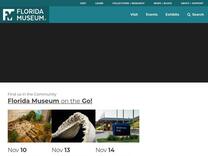Florida Museum fossils go to space – Research News https://www.floridamuseum.ufl.edu/science/florida-museum-fossils-go-to-space/
The recent launch of Blue Origin’s New Shepard rocket marked several historic milestones. The 21-year-old crew member Karsen Kitchen set a record for the youngest woman to cross the Kármán line, the boundary 62 miles overhead that separates Earth’s atmosphere from everything beyond it. It was the fi
That’s how two 56 million-year-old jaw bones and the shell of a predatory moon

